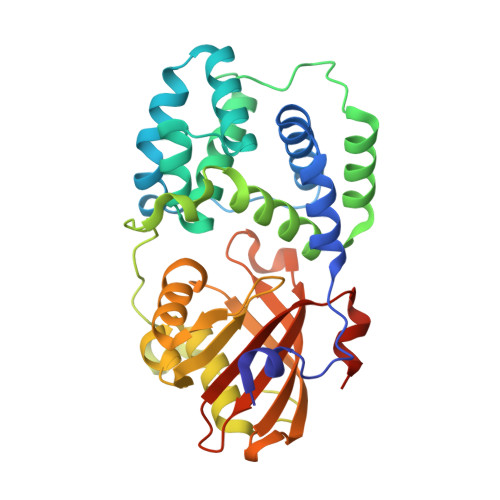Different Functions of the Paralogs to the N-Terminal Domain of the Orange Carotenoid Protein in the Cyanobacterium Anabaena sp. PCC 7120.
Lopez-Igual, R., Wilson, A., Leverenz, R.L., Melnicki, M.R., Bourcier de Carbon, C., Sutter, M., Turmo, A., Perreau, F., Kerfeld, C.A., Kirilovsky, D.(2016) Plant Physiol 171: 1852-1866
- PubMed: 27208286
- DOI: https://doi.org/10.1104/pp.16.00502
- Primary Citation of Related Structures:
5HGR - PubMed Abstract:
The photoactive Orange Carotenoid Protein (OCP) is involved in cyanobacterial photoprotection. Its N-terminal domain (NTD) is responsible for interaction with the antenna and induction of excitation energy quenching, while the C-terminal domain is the regulatory domain that senses light and induces photoactivation. In most nitrogen-fixing cyanobacterial strains, there are one to four paralogous genes coding for homologs to the NTD of the OCP. The functions of these proteins are unknown. Here, we study the expression, localization, and function of these genes in Anabaena sp. PCC 7120. We show that the four genes present in the genome are expressed in both vegetative cells and heterocysts but do not seem to have an essential role in heterocyst formation. This study establishes that all four Anabaena NTD-like proteins can bind a carotenoid and the different paralogs have distinct functions. Surprisingly, only one paralog (All4941) was able to interact with the antenna and to induce permanent thermal energy dissipation. Two of the other Anabaena paralogs (All3221 and Alr4783) were shown to be very good singlet oxygen quenchers. The fourth paralog (All1123) does not seem to be involved in photoprotection. Structural homology modeling allowed us to propose specific features responsible for the different functions of these soluble carotenoid-binding proteins.
- Institute for Integrative Biology of the Cell (I2BC), Commissariat à l'Energie Atomique, CNRS, Université Paris-Sud, Université Paris-Saclay, 91198 Gif sur Yvette, France (R.L.-I., A.W., C.B.d.C., D.K.);Institut de Biologie et Technologies de Saclay (iBiTec-S), Commissariat à l'Energie Atomique, 91191 Gif-sur-Yvette, France (R.L.-I., A.W., C.B.d.C., D.K.);MSU-DOE Plant Research Laboratory and Department of Biochemistry and Molecular Biology, Michigan State University, East Lansing, Michigan 48824 (R.L.L., M.S., A.T., C.A.K.);Department of Plant and Microbial Biology, University of California, Berkeley, California 94720 (M.R.M., C.A.K.);Physical Biosciences Division, Lawrence Berkeley National Laboratory, Berkeley, California 94720 (M.R.M., M.S., C.A.K.); andINRA, Institut Jean-Pierre Bourgin, UMR 1318, ERL CNRS 3559, Saclay Plant Sciences, F-78026 Versailles, France (F.P.).
Organizational Affiliation:

















